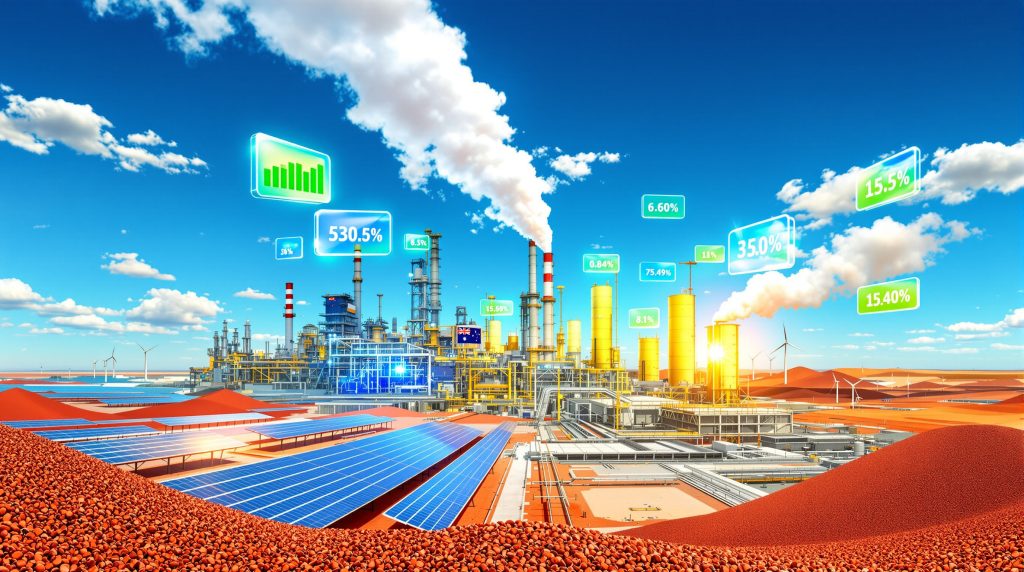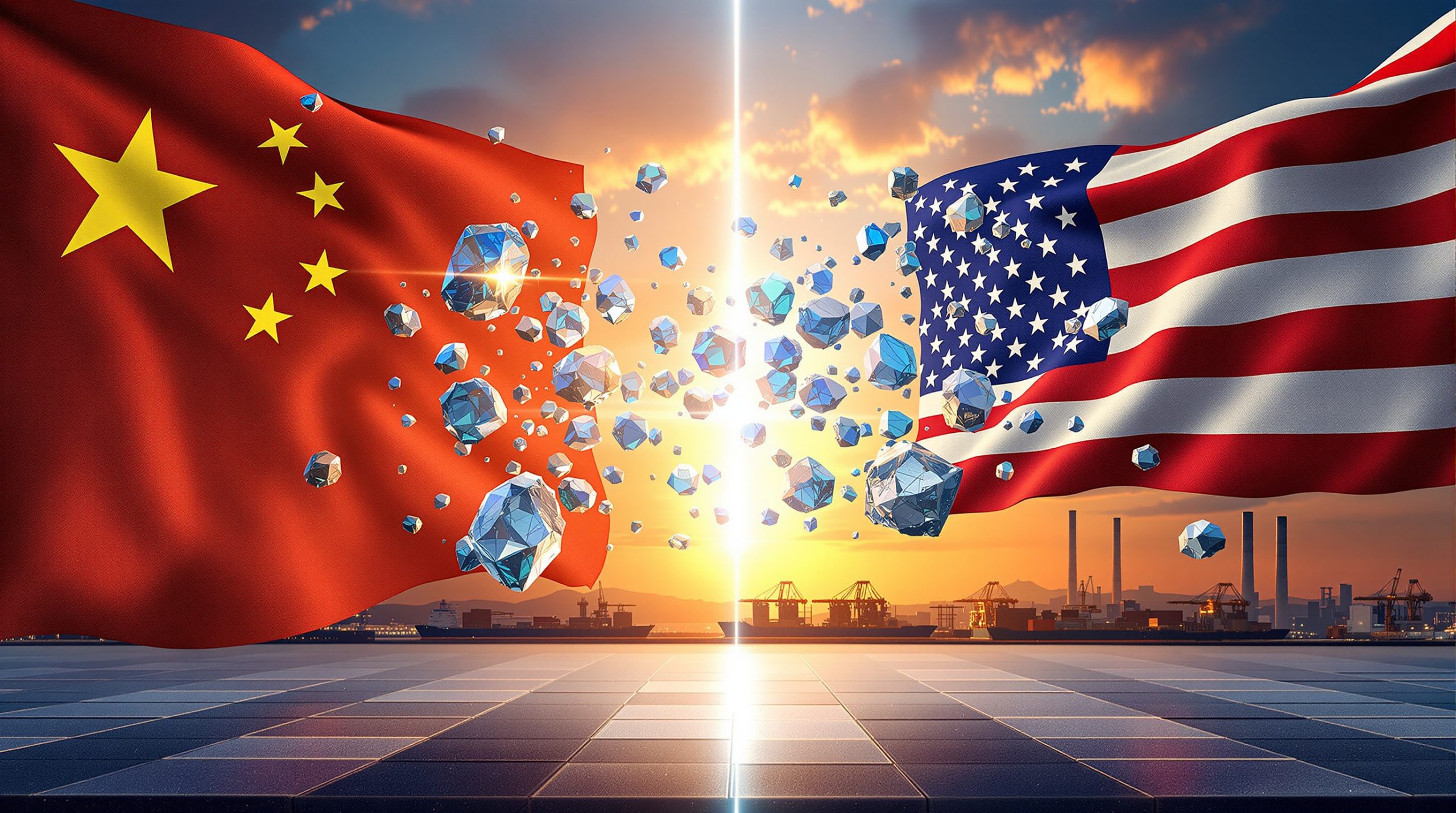What Makes Green Steel Revolutionary for Western Australia's Economy?
Green steel represents a fundamental shift away from traditional coal-based production methods, utilising renewable energy sources and advanced reduction technologies to dramatically reduce carbon emissions. Western Australia's positioning at the forefront of this transformation stems from its unique combination of abundant iron ore reserves and world-class renewable energy potential, creating unprecedented opportunities for industrial innovation through the mining industry evolution.
The state's competitive advantage lies in its ability to integrate mining resources directly with clean energy infrastructure, eliminating traditional supply chain constraints that limit other global steel producers. This integration enables Western Australia to capture value-added processing opportunities while supporting domestic manufacturing capabilities.
According to Western Australian Premier Roger Cook, locally made green steel in Western Australia represents a key component of the state's vision to become a renewable energy powerhouse and increase local manufacturing capacity. This strategic focus aims to leverage government procurement power to establish a new industrial sector while supporting decarbonisation objectives.
How is Western Australia Leading Australia's Green Steel Revolution?
The Western Australian Government has positioned green steel as a cornerstone of its economic diversification strategy through the Made in WA plan, which already supports manufacturing projects across Kwinana, the Mid West, and Pilbara regions. Furthermore, this comprehensive approach combines policy support with targeted procurement commitments to create market demand for emerging green steel production facilities.
Government Investment Framework:
• Expression of Interest process launched for green steel product suppliers
• Local sourcing requirements being implemented across government projects
• Integration with existing renewable energy and mining infrastructure
• Support for recycled feedstock utilisation from decommissioned industrial facilities
The state's leadership extends beyond domestic applications to export market opportunities. Government officials emphasise that green steel exports can help add value to raw iron ore exports, transforming Western Australia from a raw material supplier to a value-added manufacturer through sustainable mining transformation.
Key Performance Indicators:
| Application Area | Government Commitment | Timeline |
|---|---|---|
| Railway Infrastructure | Local sourcing requirements | Immediate implementation |
| Road Construction | Green steel procurement | Ongoing projects |
| Hospital Construction | Made in WA sourcing | Future building projects |
| Transmission Lines | Local steel supply | Energy infrastructure projects |
Which Major Green Steel Projects are Reshaping Western Australia?
The Collie Electric Arc Furnace Revolution
Western Australia's inaugural green steel recycling facility represents a transformational approach to steel production in the Collie region. This electric arc furnace operation will process local scrap steel into construction-grade products, utilising renewable energy sources to power the entire production process.
The facility's strategic positioning takes advantage of existing industrial infrastructure while creating new employment opportunities in a region transitioning from traditional coal-based industries. However, electric arc furnace technology offers significant environmental advantages by recycling scrap steel rather than processing raw iron ore through carbon-intensive blast furnaces.
Technical Specifications:
• Electric arc furnace powered entirely by renewable energy sources
• Local scrap steel feedstock reducing transportation requirements
• Construction-grade output targeting infrastructure development projects
• Integration with regional electricity grid and waste management systems
Geraldton's Direct Reduced Iron Innovation
The Direct Reduced Iron facility near Geraldton utilises advanced ENERGIRON technology, representing a significant investment in export-oriented green steel production. This facility will convert Western Australian iron ore into premium direct reduced iron products using natural gas initially, with planned transition to green hydrogen as supply infrastructure develops.
Direct reduced iron production offers flexibility in feedstock processing while maintaining high product quality standards suitable for premium steel applications. In addition, the facility's location near Geraldton provides strategic access to port infrastructure, supporting export market development across Asia-Pacific regions.
Strategic Elements:
• Advanced reduction technology platform
• Phased hydrogen integration as renewable supply scales
• Export market focus leveraging port infrastructure
• High-quality iron product specifications
Fortescue's Christmas Creek Green Iron Development
Located within the Pilbara's Christmas Creek operations, this pioneering facility produces green iron using hydrogen reduction processes powered by integrated solar installations. The operation represents Fortescue's broader commitment to achieving zero emissions targets while maintaining operational efficiency.
This vertically integrated approach combines renewable energy generation with iron processing, creating operational synergies that support cost competitiveness. Consequently, the facility utilises sponge iron production methodology, offering high-purity iron products suitable for specialised steel applications.
Innovation Highlights:
• Zero emissions operational target by 2030
• Integrated solar and hydrogen production infrastructure
• Advanced reduction processes producing high-purity iron
• Pilot operations expanding toward commercial production volumes
What Government Policies are Accelerating Green Steel Adoption?
The Western Australian Government's comprehensive policy framework centres on the Made in WA initiative, establishing procurement requirements that favour locally-produced green steel across major infrastructure projects. This approach creates guaranteed market demand while supporting industrial development and job creation objectives through an effective energy transition strategy.
Premier Roger Cook emphasised that the government wants to decarbonise while creating employment opportunities, using government procurement power to establish an entirely new industry sector. Furthermore, this dual focus on environmental objectives and economic development provides strong policy foundation for green steel in Western Australia investment.
Policy Framework Components:
• Mandatory local sourcing preferences for government steel procurement
• Expression of Interest processes connecting suppliers with project demand
• Integration requirements for infrastructure project specifications
• Support for recycled feedstock utilisation from industrial decommissioning
The government's approach specifically targets applications across railway construction and maintenance, road infrastructure development, hospital construction, and transmission line projects. This broad application scope ensures substantial market opportunities for emerging green steel producers.
According to the Western Australian Government's media statement, the policy framework also emphasises recycled feedstock opportunities, supporting development of green steel recycling industries that utilise decommissioned mining and offshore oil and gas plant materials.
Targeted Government Applications:
| Infrastructure Type | Procurement Approach | Market Impact |
|---|---|---|
| Railway Projects | Local sourcing requirements | Guaranteed demand volumes |
| Road Construction | Made in WA procurement | Consistent project pipeline |
| Hospital Buildings | Green steel specifications | Long-term construction demand |
| Energy Infrastructure | Local supply preferences | Transmission line projects |
How Does Green Steel Production Technology Work in Practice?
Electric Arc Furnace Methodology
Electric arc furnace technology transforms scrap steel into high-quality products using electrical energy rather than coal-based processes, dramatically reducing carbon emissions while maintaining product specifications. Western Australian facilities leverage renewable energy sources to power these operations, creating truly sustainable steel production.
The process involves melting scrap steel in electrically heated furnaces, allowing precise temperature control and metallurgical management. This technology offers flexibility in feedstock selection while supporting circular economy principles through material recycling.
Process Advantages:
• Renewable energy integration capability
• Scrap steel recycling supporting circular economy
• Precise temperature and composition control
• Reduced infrastructure requirements compared to blast furnaces
Direct Reduced Iron Processing
Direct reduced iron technology reduces iron ore using natural gas or hydrogen instead of coal-based blast furnaces, creating high-quality iron products suitable for premium steel production. This process offers energy source flexibility while maintaining operational efficiency and product quality.
The reduction process removes oxygen from iron ore at temperatures below melting point, creating sponge iron with high metallurgical value. Advanced DRI technologies like ENERGIRON provide operational flexibility and environmental performance advantages.
Technical Benefits:
• Energy source flexibility supporting transition to hydrogen
• High-quality iron products meeting premium specifications
• Lower temperature processing reducing energy requirements
• Modular plant design supporting scalable operations
Hydrogen-Based Iron Reduction
Advanced hydrogen reduction eliminates carbon emissions entirely by using hydrogen gas to extract oxygen from iron ore, producing pure iron and water vapour as the only byproducts. This technology represents the ultimate goal for zero-emission steel production.
Hydrogen reduction requires pure hydrogen supply and specialised equipment designed for hydrogen environments. The process produces high-purity iron while completely eliminating carbon dioxide emissions, supporting aggressive decarbonisation targets.
Zero Emission Characteristics:
• Hydrogen gas as sole reducing agent
• Water vapour as only process byproduct
• High-purity iron output specifications
• Integration with renewable hydrogen production systems
What Economic Benefits Will Green Steel Bring to Western Australia?
Green steel development creates substantial economic opportunities through job creation, industrial diversification, and export revenue generation. The transformation from raw material export to value-added manufacturing represents a fundamental shift in the state's economic structure, particularly in light of the current minerals demand surge.
Direct employment opportunities span operations, maintenance, and technical roles across multiple production facilities. Moreover, indirect employment benefits extend through supply chain development, supporting services, and related manufacturing activities throughout regional communities.
Economic Development Outcomes:
• Value-added processing replacing raw iron ore exports
• Manufacturing capability development for domestic infrastructure projects
• Export revenue generation through premium green steel products
• Regional economic diversification beyond traditional mining activities
The green steel sector supports broader renewable energy development, creating synergistic relationships between clean energy generation and industrial processing. This integration amplifies economic benefits while supporting Western Australia's transition to a renewable energy powerhouse.
Industry Integration Benefits:
| Sector | Integration Opportunity | Economic Impact |
|---|---|---|
| Renewable Energy | Power supply for production | Increased capacity demand |
| Mining | Iron ore value-adding | Higher export values |
| Construction | Local steel supply | Reduced import dependence |
| Logistics | Regional freight | Enhanced transport utilisation |
Government procurement commitments provide market certainty for investment decisions while supporting domestic manufacturing capabilities. This approach reduces reliance on international steel imports while creating employment opportunities in advanced manufacturing sectors.
Which Challenges Must Western Australia Overcome for Green Steel Success?
Infrastructure Development Requirements
Scaling green steel production requires coordinated infrastructure investment across renewable energy generation, hydrogen production facilities, and specialised transportation networks. The complexity of integrating these systems across multiple project timelines presents significant logistical challenges.
Renewable energy infrastructure must be scaled to support industrial processing requirements while maintaining grid stability and reliability. However, hydrogen production and storage infrastructure requires specialised safety systems and regulatory frameworks to support large-scale operations.
Infrastructure Challenges:
• Renewable energy capacity matching industrial demand profiles
• Hydrogen production, storage, and distribution networks
• Transportation infrastructure supporting raw materials and finished products
• Utilities integration across multiple production facilities
Market Development and Demand Creation
Establishing consistent market demand for premium-priced green steel requires education of commercial buyers and development of long-term procurement relationships. Government projects provide initial market foundation, but commercial market development remains essential for sector viability.
Green steel typically commands premium pricing relative to conventional products, requiring value proposition development that emphasises environmental benefits, quality specifications, and supply chain security. Market acceptance depends on customer willingness to pay for sustainability attributes.
Market Development Requirements:
• Commercial buyer education on green steel benefits
• Long-term offtake agreement development
• Competitive pricing strategies balancing premiums with market acceptance
• Quality certification and product specification standards
Technology Integration and Workforce Development
Advanced green steel technologies require specialised technical expertise currently limited within regional workforces. Training programmes, technology transfer initiatives, and international expertise recruitment become critical success factors for operational excellence.
Technology integration challenges include equipment commissioning, process optimisation, and maintenance protocols for advanced production systems. Furthermore, workforce development must address both operational roles and specialised technical positions supporting complex industrial operations.
Workforce Development Needs:
• Technical training programmes for advanced production technologies
• International expertise recruitment and knowledge transfer
• Safety training for hydrogen handling and high-temperature operations
• Management capabilities for complex industrial operations
How Does Western Australia's Green Steel Compare Globally?
Western Australia's approach to green steel development combines several unique competitive advantages that distinguish it from international competitors. Direct access to high-quality iron ore resources, abundant renewable energy potential, and existing industrial infrastructure create favourable conditions for cost-effective production.
The state's strategic location provides excellent access to Asian export markets, where demand for low-carbon steel products continues growing. In addition, government policy support through procurement commitments and local sourcing preferences creates market certainty that supports investment decisions alongside green metals leadership initiatives.
Global Competitive Positioning:
| Region | Primary Advantage | Technology Approach | Market Strategy |
|---|---|---|---|
| Western Australia | Resource integration | Multiple technology pathways | Domestic + Export focus |
| European Union | Policy framework | Hydrogen-based production | Import substitution |
| East Asia | Manufacturing scale | Efficiency optimisation | Domestic consumption |
| Middle East | Low-cost energy | Natural gas reduction | Export-oriented |
Western Australia's multi-technology approach provides operational flexibility and risk mitigation compared to regions focused on single production methods. Electric arc furnaces, direct reduced iron, and hydrogen reduction technologies offer different advantages for specific applications and market conditions.
Competitive Advantages:
• Integrated iron ore and renewable energy resources
• Multiple production technology options
• Government procurement support creating guaranteed demand
• Strategic location for Asian export market access
• Existing mining and logistics infrastructure reducing startup costs
What Does the Future Hold for Green Steel in Western Australia?
Expansion Timeline and Production Scaling
Current green steel projects represent initial phases of broader industrial transformation expected to accelerate through the 2030s. Successful demonstration of commercial viability will likely trigger additional investment rounds, expanding production capacity and technological sophistication.
The progression from pilot-scale operations to commercial production provides opportunities to optimise technologies, reduce costs, and develop skilled workforces. Consequently, this gradual scaling approach supports sustainable growth while managing technical and market risks.
Development Trajectory:
• 2025-2027: Initial facility commissioning and ramp-up
• 2027-2030: Commercial production establishment and optimisation
• 2030-2035: Capacity expansion and additional facility development
• Beyond 2035: Full industrial ecosystem maturation
Integration with Renewable Energy Development
Green steel facilities will drive substantial additional renewable energy investment, creating synergistic development between clean energy generation and industrial processing. This integration supports broader decarbonisation objectives across multiple economic sectors.
The industrial demand profile for steel production complements renewable energy generation patterns, potentially improving grid stability and renewable energy project economics. Battery storage and grid management technologies will play crucial roles in optimising energy utilisation.
Energy Sector Integration:
• Large-scale renewable energy project development
• Grid stability improvements through industrial demand management
• Energy storage system deployment supporting variable renewable generation
• Hydrogen production and storage infrastructure development
Export Market Development Opportunities
Western Australia's strategic positioning enables premium green steel product exports to Asian markets increasingly focused on supply chain decarbonisation. This export potential significantly expands market opportunities beyond domestic demand constraints.
International carbon pricing mechanisms and supply chain sustainability requirements create competitive advantages for verified low-carbon steel products. Furthermore, export market development supports larger-scale production facilities with improved cost competitiveness as part of green steel in Western Australia development.
Export Market Drivers:
• Asian market demand for low-carbon steel products
• International carbon pricing and border adjustment mechanisms
• Supply chain sustainability requirements in target markets
• Premium pricing for verified green steel products
Frequently Asked Questions About Green Steel in Western Australia
What distinguishes green steel from traditional steel production methods?
Green steel eliminates coal-based production processes by utilising renewable energy, hydrogen reduction, or electric arc furnaces that can achieve substantial carbon emission reductions compared to conventional blast furnace operations. The environmental benefits come from substituting clean energy sources for coal-based processes.
When will Western Australian green steel become commercially available?
Initial production facilities are expected to begin operations in the 2027 timeframe, with multiple projects becoming operational between 2027-2028. This timeline provides substantial green steel supply for both domestic infrastructure projects and export markets.
How will green steel pricing compare to conventional steel products?
Green steel initially commands premium pricing reflecting higher production costs and environmental benefits. However, local production, renewable energy integration, and economies of scale are expected to improve cost competitiveness within 5-7 years of commercial operation.
Which industries will benefit most from Western Australian green steel availability?
Construction, infrastructure development, renewable energy projects, and manufacturing sectors will see immediate benefits from local green steel supply. Government procurement commitments ensure consistent demand across railway, road, hospital, and energy infrastructure projects.
How does government procurement support green steel development?
The Western Australian Government uses procurement power to create guaranteed market demand through local sourcing requirements, Expression of Interest processes, and integration with the Made in WA plan. This approach provides market certainty supporting investment decisions.
What role does recycled feedstock play in green steel production?
Recycled steel feedstock from decommissioned mining and offshore oil and gas facilities provides material for electric arc furnace operations, supporting circular economy principles while creating additional supply sources for green steel in Western Australia production.
How does Western Australia's approach compare to international green steel initiatives?
Western Australia combines resource integration advantages with multiple technology pathways, government procurement support, and strategic export market positioning. This comprehensive approach provides competitive advantages relative to regions dependent on single technologies or limited policy support.
What are the main technical challenges facing green steel development?
Infrastructure development coordination, technology integration complexity, and workforce development represent primary technical challenges. Success requires aligned investment in renewable energy, hydrogen production, and specialised industrial facilities while developing appropriate technical expertise.
The Western Australian Government's commitment to green steel development demonstrates the state's leadership in sustainable industrial transformation. Through strategic procurement policies and support for multiple production technologies, Western Australia is positioning itself as a global leader in low-carbon steel production while creating new economic opportunities for local communities.
Disclaimer: This analysis includes forward-looking statements about green steel development in Western Australia based on current government announcements and industry projections. Actual outcomes may vary due to technological developments, market conditions, regulatory changes, and other factors beyond current visibility. Investment and business decisions should consider comprehensive risk assessments and professional advice.
Ready to Capitalise on Western Australia's Green Steel Revolution?
Discovery Alert's proprietary Discovery IQ model delivers real-time alerts on significant mineral discoveries across Western Australia's evolving industrial landscape, instantly empowering subscribers to identify actionable opportunities ahead of the broader market. Begin your 30-day free trial today and secure your market-leading advantage as the green steel transformation creates new investment possibilities.




